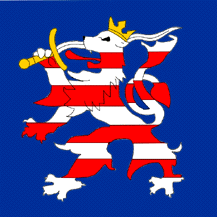Hesse-Darmstadt





(1813-1871: Hessen (-Darmstadt))
The Grand Duchy of Hesse-Darmstadt was a German state since 1567. The Landgrave of Hessen-Darmstadt became the Grand Duke of Hesse (Großherzöge von Hessen) in 1806 after being forced to join Napoleon I’s Rhine Alliance. After Napoleon’s army had been defeated in 1815, Hesse Darmstadt’s territory was enlarged to include cities near the Rhine River, such as Mainz. The official title was changed from Hesse-Darmstadt to “Hesse and the Rhine” (Hessen und bei Rhein). It was a member state of the Germanic Confederation between 1815 and 1866. She sided with Austria during the war in 1866. After the Prussian-Austrian War, she became a member state of the North German Confederation. It was known until 1866 as Hesse-Darmstadt. After the annexation of Hesse-Cassel and Hesse-Homburg by Prussia in 1866, Hesse-Darmstadt remained the only independent part of Hesse, and it became known as Hesse. Not only were the inhabitants known as Hessians, but so were inhabitants of the former states of Hesse and the new Prussian province of Hesse-Nassau. Hesse-Darmstadt became a member state of the German Empire in 1871. It consisted of two main parts, separated from each other by a narrow strip of Prussian territory. The northern part was the province of Oberhessen; the southern consisted of the contiguous provinces of Starkenburg and Rheinhessen. It is a common misconception that Hesse-Darmstadt lost no land as a result of royal connections after the war of 1866. While doing far better than many of its neighbors, she still lost a great deal of land north of Welzlar.
The Hessian military became a contingent of the Prussian army on 7 April 1867. Even though only the northern part of Hesse joined the North German Confederation, the entire military was integrated into the Prussian army. There were some significant variances with other conventions and there even was a separate War Minister for Hesse. A further convention was signed in June 1871 maintaining more control over uniforms and other functions than most of the other small states. The Grand Duke retained the right to order any changes in the uniform, which may be found in later imperial orders.
The form of government was a hereditary constitutional monarchy. There were two legislative chambers in the parliament both called Kammer. The upper consisted of princes of the grand-ducal family, heads of noble houses, the Bishop of the Roman Catholic Church, the superintendent of the protestant church, the chancellor of the university, two elected representatives of the land-owning nobility, and twelve members nominated by the Grand Duke. The lower chamber consisted of 50 members who were indirectly elected by deputy electors (Wahlmänner). The voting right was offered to all taxpayers, and was secret and direct.
In 1894, the Grand Duke married Victoria Melita of Great Britain. Despite the birth of a daughter, this was not a happy marriage. Victoria Melita’s (Ducky’s) fights with the passive Ernst were legendary and included the throwing of china and glassware. They were divorced in 1901. There is controversy today whether the Grand Duke was gay or bisexual or if Victoria Melita created this rumor maliciously. He married again in 1905.
Consuls were maintained for trade with Bremen, Hamburg, Bavaria, Austria-Hungary, Württemberg, Belgium, Italy, Spain, Great Britain, Russia, Prussia, Saxony, Brazil, Guatemala, Mexico, Italy, Nicaragua, the Netherlands, Paraguay, Peru, Portugal, Saxony, Sweden, Serbia, Spain, Venezuela, USA, France, Greece, Great Britain, Rumania, Norway, Switzerland, and Turkey.
The capital was Darmstadt. There were 1,333,000 inhabitants in 1914.
